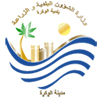
Back الوكرة Arabic الوكره ARZ الوکره AZB Al Wakrah BAN Эль-Вакра BE-X-OLD Уакра Bulgarian Al Wakrah Catalan Al Wakrah (kapital sa munisipyo) CEB ئەلوەکرا CKB Al-Wakra Czech
This article needs to be updated. (April 2024) |
Al Wakrah
الوكرة | |
|---|---|
Top to Bottom, Left to Right: A lone fishing vessel on the coastline, Workers traveling along Al Wakrah Corniche in the Al Wakrah Heritage Village, Traditional stone buildings in Al Wakrah Heritage Village, Renovated fort of Sheikh Abdulrahman bin Jassim Al Thani (now known as Al Wakrah Fort) | |
| Coordinates (Al Wakrah): 25°10′48″N 51°36′36″E / 25.18000°N 51.61000°E | |
| Country | |
| Municipality | Al Wakrah Municipality |
| Area | |
| • Total | 75.8 km2 (29.3 sq mi) |
| Population (2015)[1] | |
| • Total | 87,970 |
| • Density | 1,200/km2 (3,000/sq mi) |
| Time zone | UTC+03 |
| ISO 3166 code | QA-WA |
Al Wakrah (Arabic: الوكرة, romanized: al-Wakra) is the capital city of the Al Wakrah Municipality in Qatar. Al Wakrah's eastern edge touches the shores of the Persian Gulf and Qatar's capital Doha is situated to the city's immediate north. Governed by Sheikh Abdulrahman bin Jassim Al Thani, it was originally a small fishing and pearling village. Over the years, it evolved into a small city with a population of more than 80,000 and is currently considered the second most populous city in Qatar.[2]
The city was historically used as a pearling center during the period in which Qatar's economy was almost entirely dependent on the bustling pearling industry.[3][4] According to the United States Hydrographic Office, by 1920, there were approximately 300 ships situated in the town.[5] A following study carried out by the British in 1925 stated that there were 250 boats in Wakrah's port.[6] Al Wakrah was thought to encompass the so-called 'Pirate Coast', as stated by a report written in 1898.[7]
It has undergone extensive development and growth since the turn of the 21st century while also being steadily encroached on by rapidly expanding Doha from the north. Notable milestones in the city's modern history include the May 2019 inauguration of Al Janoub Stadium, a venue for the Qatar 2022 World Cup,[8] the opening of Al Wakrah Heritage Village in 2016,[9] the Al Wakrah Main Road Project,[10] and the city's integration into the Doha Metro's Red Line.[11]
- ^ "2015 Population census" (PDF). Ministry of Development Planning and Statistics. April 2015. Archived from the original (PDF) on 17 July 2016. Retrieved 8 August 2017.
- ^ "Qatar's growing economy continues to provide high standard of living". Oxford Business Group. 21 January 2018. Retrieved 14 July 2018.
- ^ Schulte-Peever, Andrea; Shearer, Iain (1 September 2013). Oman, UAE & Arabian Peninsula. Lonely Planet. p. 279. ISBN 978-1742200095. Retrieved 12 January 2014.
- ^ Fromherz, Allen (13 April 2012). Qatar: A Modern History. Georgetown University Press. ISBN 978-1-58901-910-2.
- ^ Publications, Issue 158. United States Hydrographic Office. 1920. p. 112. Retrieved 12 January 2015.
- ^ "'Gazetteer of the Persian Gulf. Vol. II. Geographical and Statistical. J G Lorimer. 1908' [1925] (2052/2084)". Qatar Digital Library. Retrieved 12 January 2015.
- ^ "'PERSIAN GULF AND GULF OF OMAN. RESOURCES AND COAST DEFENCES.' [18] (24/114)". Qatar Digital Library. Retrieved 12 January 2015.
- ^ "Tradition and innovation come together as striking Al Janoub Stadium in Al Wakrah City is opened". FIFA. 16 May 2019. Retrieved 18 May 2019.
- ^ "New Heritage Village opens in Al Wakra Beach". NRICafe.com. 19 February 2016. Archived from the original on 9 January 2019. Retrieved 9 January 2019.
- ^ "Al Wakrah Main Road project: Traffic diversions from Saturday". Gulf Times. 26 October 2018. Retrieved 9 January 2019.
- ^ "Red Line". Qatar Rail. Retrieved 9 January 2019.
© MMXXIII Rich X Search. We shall prevail. All rights reserved. Rich X Search







